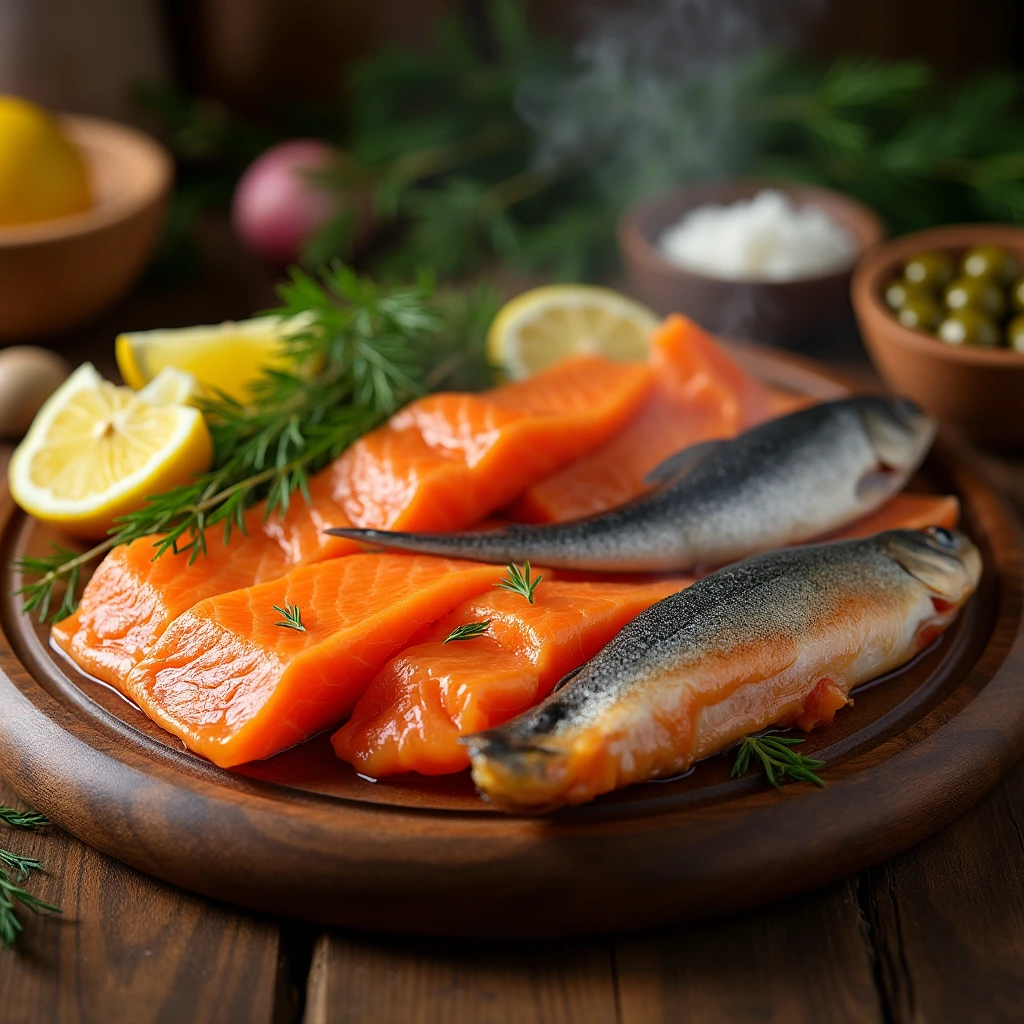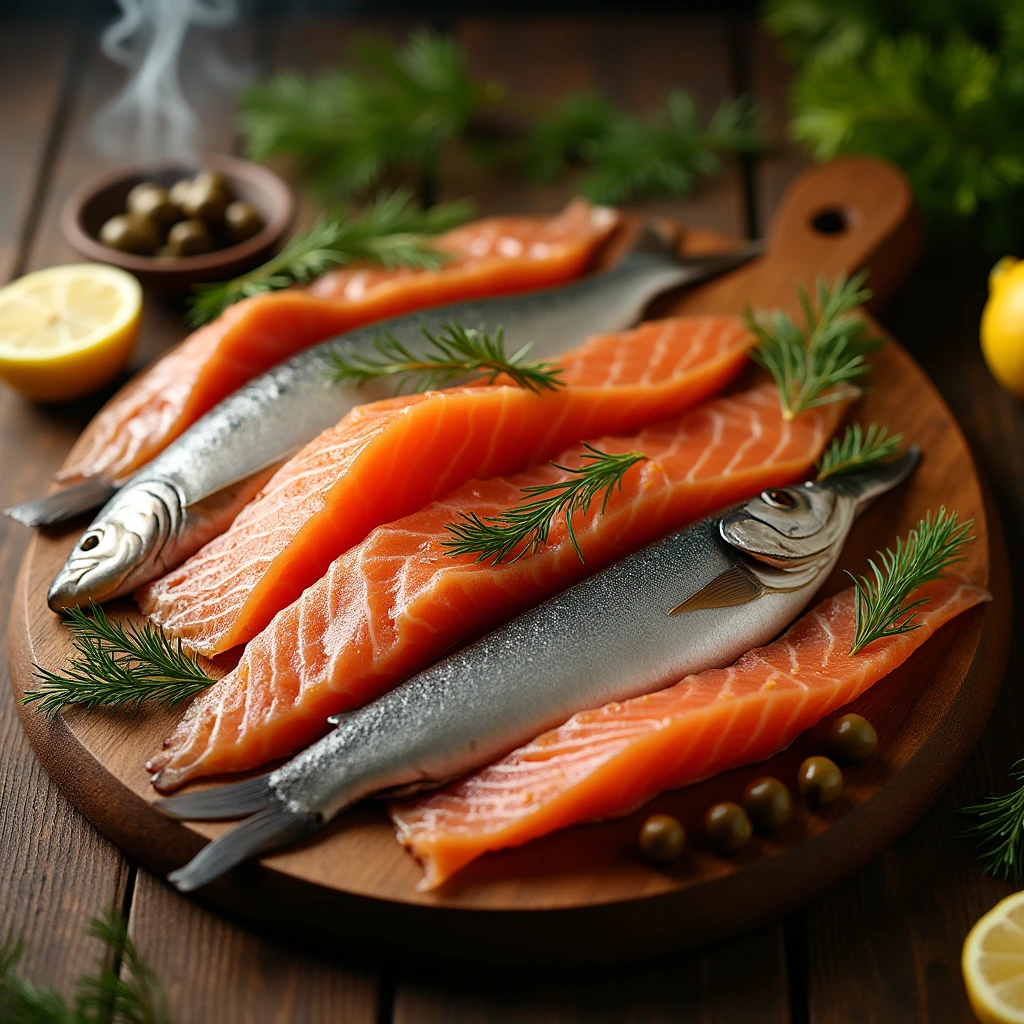Introduction
Smoked fish enriches culinary traditions worldwide, offering rich flavor and lasting preservation. This ancient technique uses smoke from burning wood to cure fish, extending its shelf life and enhancing taste.

Coastal communities developed smoking methods to store seafood during lean periods. Today, it serves as a gourmet ingredient in dishes like pâtés, salads, and sushi. Smoked fish highlights regional traditions, including Jewish lox, Scandinavian gravlax, and Japan’s katsuo-bushi (smoked bonito).
The smoking process infuses fish with unique flavors, shaped by the type of wood and seasonings. Its versatility secures its role in traditional and modern cuisines, continually inspiring chefs and delighting food lovers worldwide.
The History of Smoked Fish
Early Preservation Methods: Origins of Smoking as a Preservation Technique
Smoking fish began as an essential preservation technique in ancient civilizations. Early communities, particularly in coastal and riverine areas, sought reliable methods to prevent spoilage in their abundant catches. Consequently, they discovered that smoking combined the drying effects of heat with the antibacterial properties of smoke, which effectively extended the shelf life of fish.
The process involved curing fish over smoldering wood fires, a practice that not only preserved it but also enhanced its flavor. Over time, as societies evolved, various cultures refined this technique. They incorporated local wood types and seasonings, thereby creating distinctive flavors and laying the groundwork for diverse regional smoking traditions.
Cultural Significance: Role of Smoked Fish in Global Cuisines
Smoked fish has long played a significant role in global cuisines, symbolizing both tradition and creativity. For instance, in Scandinavia, smoked salmon and herring are integral to traditional diets, reflecting the region’s reliance on seafood. Similarly, Jewish communities introduced smoked lox, which became iconic when paired with bagels and cream cheese. Meanwhile, in Japan, katsuo-bushi (smoked bonito) remains crucial for making dashi, a fundamental stock in Japanese cooking.
Today, smoked fish continues to bridge its historic purpose and modern culinary innovation. Its enduring popularity demonstrates a universal appreciation for its bold, smoky flavors and cultural heritage.
The Science Behind Smoking Fish
How Smoking Preserves Fish: Chemical Processes Involved
Smoking preserves fish through a combination of dehydration, chemical changes, and the introduction of protective compounds. The process begins with curing, where salt draws out moisture and creates an inhospitable environment for bacteria. During smoking, heat further dehydrates the fish, reducing water activity and slowing spoilage.
The smoke itself contains phenols, formaldehyde, and acids, which act as natural preservatives. These compounds penetrate the fish, killing bacteria and preventing oxidation that can lead to rancidity. Additionally, the smoke forms a protective coating on the fish’s surface, creating a barrier against environmental contaminants. Together, these chemical processes ensure the fish remains safe to eat for longer periods while maintaining its nutritional value.
Flavor Transformation: The Impact of Smoking on Taste and Texture
Smoking not only preserves fish but also transforms its flavor and texture. As the smoke infuses the fish, it introduces aromatic compounds such as phenols and carbonyls, which contribute to the characteristic smoky taste. The type of wood used, such as oak or hickory, also affects the flavor profile, adding unique nuances.
Texture changes as smoking dehydrates the fish. It becomes firmer and sometimes flaky, depending on the method used. These changes enhance the fish’s culinary appeal, making smoked fish a delicacy enjoyed worldwide for its robust flavor and satisfying texture.
Popular Types of Smoked Fish
Salmon: Varieties and Preferences
Smoked salmon is a global favorite, prized for its rich, buttery texture and mild, smoky flavor. It comes in two main styles: cold-smoked and hot-smoked. Cold-smoked salmon, often thinly sliced, has a delicate texture and subtle smokiness, making it perfect for bagels or canapés. Hot-smoked salmon, by contrast, is firmer and has a deeper flavor, often enjoyed on its own or in salads. Popular varieties include Atlantic salmon and Pacific species like sockeye and king salmon, each offering unique taste profiles influenced by their fat content and smoking process.
Mackerel: A Robust and Flavorful Choice
Smoked mackerel is loved for its bold flavor and firm, oily texture. Its high fat content absorbs smoke beautifully, resulting in a rich and satisfying taste. Popular in European and Asian cuisines, smoked mackerel is often seasoned with pepper or spices, enhancing its naturally robust flavor. It is versatile, enjoyed as a snack, in pâtés, or as an ingredient in hearty dishes.
Whitefish and Others: Regional Favorites and Specialties
Whitefish, including species like cod, haddock, and trout, are regional staples in smoked fish traditions. Smoked whitefish is a favorite in Jewish delis, while smoked haddock is essential in British dishes like kedgeree. Additionally, regional specialties such as smoked eel in Europe or smoked catfish in the southern United States highlight the diversity of smoked fish enjoyed worldwide.
Methods of Smoking Fish
Hot Smoking: Process and Uses
Hot smoking is a faster method that cooks and smokes fish simultaneously at temperatures between 120°F and 180°F (49°C to 82°C). The fish is cured with salt beforehand to enhance flavor and reduce moisture. During smoking, the heat not only preserves but also fully cooks the fish, creating a firm texture and deep smoky flavor. Hot-smoked fish, such as salmon and mackerel, is ready to eat and commonly used in salads, pasta, or as a standalone dish.
Cold Smoking: Technique and Applications
Cold smoking preserves fish without cooking it, as it is done at lower temperatures, typically between 68°F and 86°F (20°C to 30°C). The fish is cured to remove moisture and smoked over an extended period, allowing the flavors to develop slowly. This method produces a delicate texture and subtle smokiness, ideal for fish like salmon or haddock. Cold-smoked fish often requires cooking or careful handling before consumption, making it a popular choice for appetizers, sushi, or sandwiches.
Modern Innovations: Electric Smokers and Hybrid Methods
Modern technology has revolutionized smoking techniques with electric smokers and hybrid methods. Electric smokers provide precise temperature control, making both hot and cold smoking easier for home cooks. Hybrid methods combine traditional smoking with sous-vide or flash-freezing, ensuring consistent results and preserving the fish’s texture and flavor. These innovations make smoking fish more accessible and versatile than ever.
Benefits of Eating Smoked Fish
Nutritional Advantages: Omega-3s, Vitamins, and Minerals
Smoked fish is a nutrient-rich food that offers significant health benefits. It is an excellent source of omega-3 fatty acids, essential for heart health, brain function, and reducing inflammation. Additionally, it provides high-quality protein, making it a valuable addition to a balanced diet. Smoked fish also contains essential vitamins such as B12, which supports energy production, and minerals like selenium, which boosts immune function. The smoking process preserves most of these nutrients, ensuring a nutritious and flavorful option for health-conscious consumers.
Culinary Versatility: Uses in Recipes, Appetizers, and Main Courses
Smoked fish shines in its versatility, making it a popular choice in various culinary applications. It can enhance appetizers, such as smoked salmon canapés or mackerel pâté. Smoked fish is also a key ingredient in recipes like chowders, pasta dishes, or salads, adding depth and complexity to flavors. Its bold taste and appealing texture make it a favorite for creative chefs and home cooks alike, whether as a feature in elegant meals or casual snacks.
Longevity and Convenience: Ideal for Storage and Quick Meals
The smoking process extends the shelf life of fish, making it an ideal pantry staple. Smoked fish’s ready-to-eat nature allows for quick and easy meals, perfect for busy lifestyles. Its combination of longevity, nutrition, and convenience ensures it remains a staple in kitchens around the world.
Potential Concerns and Considerations
Health Impacts: Salt and Potential Additives
While smoked fish is nutritious, it is important to consider its sodium content and potential additives. The curing process involves salting, which can lead to high levels of sodium that may pose risks for individuals with hypertension or cardiovascular concerns. Additionally, some commercially smoked fish may contain preservatives, artificial flavors, or nitrates to enhance shelf life and appearance. These additives, if consumed in excess, could impact health. Choosing high-quality smoked fish with minimal processing and reading labels carefully can help mitigate these risks.
Sustainability: Ethical Considerations for Sourcing Fish
Sustainability is a growing concern when sourcing smoked fish. Overfishing, habitat destruction, and unsustainable farming practices threaten marine ecosystems and fish populations. Consumers should prioritize sustainably sourced fish, such as those certified by organizations like the Marine Stewardship Council (MSC) or Aquaculture Stewardship Council (ASC). Supporting responsible fisheries and avoiding species at risk of overexploitation can promote healthier oceans and ensure the availability of smoked fish for future generations. By staying informed about sourcing practices, individuals can enjoy smoked fish while supporting ethical and environmentally friendly choices.
Smoked Fish Recipes to Try
Classic Smoked Salmon Bagel: A Beloved Breakfast Recipe
A smoked salmon bagel is a timeless favorite, perfect for a satisfying breakfast or brunch. Start with a toasted bagel and spread a generous layer of cream cheese. Add thin slices of smoked salmon, followed by toppings like red onion, capers, and fresh dill. For an extra burst of flavor, drizzle with lemon juice or sprinkle with black pepper. This simple yet elegant dish pairs well with coffee or tea and is a hit at any gathering.
Smoked Fish Chowder: A Hearty, Comforting Dish
Smoked fish chowder is a rich, warming dish ideal for cold days. Begin by sautéing onions, celery, and garlic in butter. Add diced potatoes, fish stock, and cream to create a creamy base. Flake in smoked fish, such as haddock or trout, and simmer until heated through. Finish with a touch of fresh parsley or chives for garnish. This chowder is a comforting meal that highlights the smoky, savory flavors of the fish.
Creative Salads and Dips: Light and Flavorful Ideas
Smoked fish adds depth to light dishes like salads and dips. Toss flaked smoked mackerel with mixed greens, citrus segments, and a vinaigrette for a refreshing salad. Alternatively, blend smoked fish with cream cheese, lemon, and dill to create a crowd-pleasing dip, perfect for crackers or vegetable sticks. These ideas showcase smoked fish’s versatility and enhance any menu.
FAQs
Which fish are best for smoking?
Fatty fish are ideal for smoking because their higher fat content absorbs smoke well, enhancing flavor and texture. Popular choices include salmon, mackerel, trout, herring, and whitefish. Leaner fish, like cod or tilapia, can also be smoked, but they may require additional brining to retain moisture.
How long do you smoke fish?
The smoking time depends on the method used. For hot smoking, fish typically takes 1 to 4 hours at temperatures between 120°F and 180°F (49°C to 82°C). Cold smoking requires a longer process, often 12 to 48 hours, at lower temperatures (68°F to 86°F or 20°C to 30°C) to achieve the desired flavor and texture.
Is smoked fish healthy to eat?
Smoked fish is a nutritious food, rich in omega-3 fatty acids, protein, and essential vitamins. However, it can be high in sodium due to the curing process. Moderation and choosing minimally processed options are key to maintaining its health benefits.
Do you need to brine fish before smoking?
Yes, brining is recommended before smoking. It enhances flavor, draws out moisture, and helps preserve the fish. A simple brine of salt, sugar, and water works well, though additional spices and herbs can be added for extra flavor.
Additional Ressources
To deepen your understanding of smoked fish and explore its various aspects, here are some external resources worth visiting. For an in-depth look at sustainable seafood options, check out the Marine Stewardship Council’s official website, where you can learn about certifications and ethical sourcing. If you’re curious about the nutritional benefits of fish, including smoked varieties, the American Heart Association offers valuable insights into omega-3 fatty acids and their impact on heart health. For home cooks interested in trying smoking techniques, the Food Network provides step-by-step guides and recipes for both hot and cold smoking.
Additionally, you can explore unique smoked fish recipes on BBC Good Food, which includes everything from smoked fish pâtés to comforting chowders. To ensure your smoked fish is sourced responsibly, organizations like the Seafood Watch offer consumer guides tailored to sustainable practices. If you’re keen on understanding the science behind smoking, articles from Science Direct provide detailed explanations of the chemical processes involved. These resources can help you enjoy smoked fish responsibly while expanding your culinary skills and knowledge.
You can discover more pie recipes on our website:
- Choco Pie
- Passover Potato Pie
- Pickle Pie Pizza
- Pecan Pie Cheesecake
- Milk Bar Pumpkin Pie
- Pecan Pie Cheesecake
- Pumpkin Pie Recipe Condensed Milk
Conclusion
Smoked fish is a culinary treasure that blends tradition, practicality, and gourmet appeal. Its origins as a preservation method highlight the ingenuity of early societies in extending the shelf life of their catch. Today, smoked fish is celebrated not just for its longevity but for the rich, smoky flavors and textures it brings to diverse cuisines.
Versatile and nutritious, smoked fish complements countless dishes, from classic smoked salmon bagels to hearty chowders and refreshing salads. Its high content of omega-3 fatty acids, protein, and essential vitamins makes it a valuable addition to a balanced diet, while its bold flavors elevate both simple and sophisticated recipes.
While enjoying smoked fish, it’s essential to consider sustainability and health aspects. Choosing responsibly sourced options and being mindful of sodium levels can ensure an ethical and wholesome experience.
Whether as a snack, a main course, or an ingredient in creative culinary creations, smoked fish continues to captivate taste buds worldwide. Its enduring popularity reflects its unique ability to connect tradition with innovation, making it a timeless favorite for food lovers everywhere.

